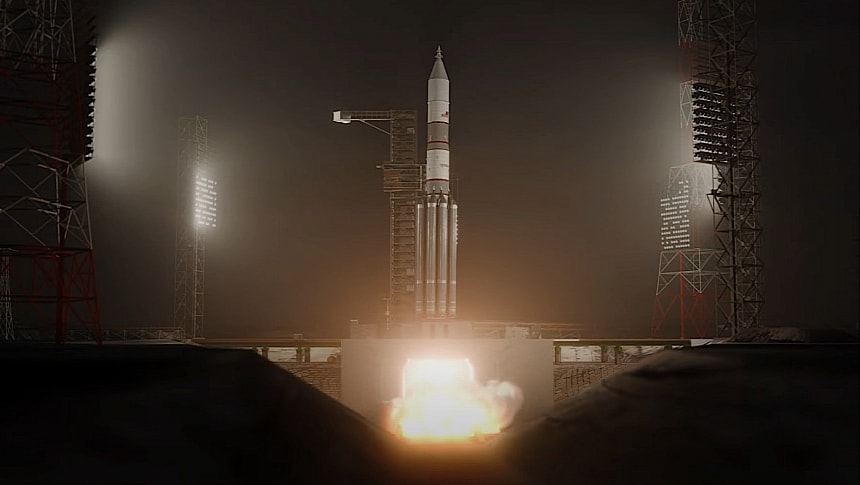If you really look at space exploration objectively, you'll realize there are more failures and unfulfilled dreams than successes and reasons to be proud. In any other industry that would be very bad, as it would be an indicator things are not going according to plan. But not here. In space exploration, every failure and unfulfilled dream contributed to bringing humanity where it is now.
For several decades after the start of the space race there were technically two major powers that competed in this field. For many years the United States and the Soviet Union went to head trying to best each other and become the rulers of the space around us.
As history unfolded the U.S. won the race, and that also means America has a lot more failed space projects than the Russians. But these guys don't fall far behind either, and some of the hardware they envisioned over the years was truly spectacular.
Just look at the thing we have here. It was called the Energia Vulkan, and it was supposed to be a heavy-lift rocket that could carry humans to the Moon and perhaps all the way to Mars, too. It was never made in real life, but thankfully modern tech and talented digital artists brought it back for us all to admire.
The Vulkan was first envisioned by the Russians in the early 1980s, and borrowed the name from an earlier heavy-lift rocket design that was eventually dropped a few years before. It was supposed to be the largest of the rockets made by local space behemoth Energia.
The rocket was meant to lift off from the world-famous launch pad at the Baikonur Cosmodrome in Kazakhstan, and it should have been capable of carrying 200 tons of cargo to an orbit 200 km (124 miles), 43 tons to the Moon, and as much as 52 tons all the way to Mars.
Helping it do that were no less than eight Zenit rocket boosters wrapped around an Energia-M upper stage. RD-0120 engines would have given the rocket 175 tons of thrust at sea level and 200 tons in space.
On top of the entire assembly, there was supposed to be a cone that would have been reconfigurable to support various payloads. Most of the rocket, which was part of the same family as the Zenit, Energia, or Bourane-T rockets, was not reusable in any way.
The Soviets worked on the Energia Vulkan for about a decade, but the project was eventually scrapped in the 1990s when the Soviet Union fell, and funding abruptly disappeared. That means the Vulkan never got to fly in real life.
Yet here it is, doing an impressive job in a computer simulation put together by space animation specialist Hazegrayart. You can enjoy the rocket in CGI action below this text.
As history unfolded the U.S. won the race, and that also means America has a lot more failed space projects than the Russians. But these guys don't fall far behind either, and some of the hardware they envisioned over the years was truly spectacular.
Just look at the thing we have here. It was called the Energia Vulkan, and it was supposed to be a heavy-lift rocket that could carry humans to the Moon and perhaps all the way to Mars, too. It was never made in real life, but thankfully modern tech and talented digital artists brought it back for us all to admire.
The Vulkan was first envisioned by the Russians in the early 1980s, and borrowed the name from an earlier heavy-lift rocket design that was eventually dropped a few years before. It was supposed to be the largest of the rockets made by local space behemoth Energia.
The rocket was meant to lift off from the world-famous launch pad at the Baikonur Cosmodrome in Kazakhstan, and it should have been capable of carrying 200 tons of cargo to an orbit 200 km (124 miles), 43 tons to the Moon, and as much as 52 tons all the way to Mars.
Helping it do that were no less than eight Zenit rocket boosters wrapped around an Energia-M upper stage. RD-0120 engines would have given the rocket 175 tons of thrust at sea level and 200 tons in space.
On top of the entire assembly, there was supposed to be a cone that would have been reconfigurable to support various payloads. Most of the rocket, which was part of the same family as the Zenit, Energia, or Bourane-T rockets, was not reusable in any way.
The Soviets worked on the Energia Vulkan for about a decade, but the project was eventually scrapped in the 1990s when the Soviet Union fell, and funding abruptly disappeared. That means the Vulkan never got to fly in real life.
Yet here it is, doing an impressive job in a computer simulation put together by space animation specialist Hazegrayart. You can enjoy the rocket in CGI action below this text.









